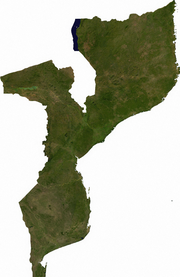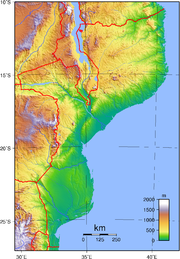
Geography of Mozambique
Did you know...
SOS Children, an education charity, organised this selection. SOS Children works in 45 African countries; can you help a child in Africa?
Location: Southern Africa, bordering the Mozambique Channel, between South Africa and Tanzania
Geographic coordinates: 18°15′S 35°00′E
Map references: Africa
Area:
total: 801 590 km²
land: 784 090 km²
water: 17 500 km²
Capital
- Maputo (Lourenço Marques)
Major Cities
- Matola
- Nampula
- Beira
- Chimoio
- Nacala
- Quelimane
- Tete
- Lichinga
- Pemba (Porto Amelia)
Other Cities
- Angoche (António Enes)
Area - comparative:
Belarus: slightly less than four times the size of Belarus.
Kyrgyzstan: slightly more than four times the size of Kyrgyzstan.
Iran: slightly less than half the size of Iran.
Pakistan: slightly less than the size of Pakistan.
Paraguay: slightly less than twice the size of Paraguay.
United States: slightly less than twice the size of California.
Zimbabwe: slightly more than twice the size of Zimbabwe.
Land boundaries:
total: 4 571 km
border countries: Malawi 1 569 km, South Africa 491 km, Swaziland 105 km, Tanzania 756 km, Zambia 419 km, Zimbabwe 1 231 km
Coastline: 2 470 km
Maritime claims:
exclusive economic zone: 200 nmi (370.4 km; 230.2 mi)
territorial sea: 12 nmi (22.2 km; 13.8 mi)
Terrain: mostly coastal lowlands, uplands in centre, high plateaus in northwest, mountains in west
Elevation extremes:
lowest point: Indian Ocean 0 m
highest point: Monte Binga 2 436 m
Natural resources: coal, titanium, natural gas, hydropower, tantalum, graphite
Land use:
arable land: 5.43% (2005 est.), 3.98% (1998 est.)
permanent crops: 0.29% (2005 est.), 0.29% (1998 est.)
other: 94.28% (2005 est.), 95.73% (1998 est.)
Irrigated land: 1 180 km² (1993 est.)
Natural hazards: severe droughts; devastating cyclones and floods occur in central and southern provinces
Environment - current issues: a long civil war and recurrent drought in the hinterlands have resulted in increased migration of the population to urban and coastal areas with adverse environmental consequences; desertification; pollution of surface and coastal waters; elephant poaching for ivory is a problem
Environment - international agreements:
party to: Biodiversity, Climate Change, Desertification, Endangered Species, Hazardous Wastes, Law of the Sea, Ozone Layer Protection
signed, but not ratified: none of the selected agreements
Ecoregions
- Eastern Miombo woodlands
- Eastern Zimbabwe montane forest-grassland mosaic
- Maputaland coastal forest mosaic
- Southern Miombo woodlands
- Southern Rift montane forest-grassland mosaic
- Southern Zanzibar-Inhambane coastal forest mosaic
- Zambezian coastal flooded savanna
- Zambezian flooded grasslands
- Zambezian halophytics
- Zambezian and Mopane woodlands
- East African mangroves
Climate
Mozambique has a tropical climate with two seasons, a wet season from October to March and a dry season from April to September. Climatic conditions, however, vary depending on altitude. Rainfall is heavy along the coast and decreases in the north and south. Annual precipitation varies from 500 to 900 mm (19.7 to 35.4 in) depending on the region with an average of 590 mm (23.2 in). Cyclones are also common during the wet season. Average temperature ranges in Maputo are from 13 to 24 °C (55.4 to 75.2 °F) in July to 22 to 31 °C (71.6 to 87.8 °F) in February.
Physical Features
The coastline extends from 26° 52' S. to 10° 40' S., and from south to north makes a double curve with a general trend outward to the east. It has a length of 1,430 miles (2,300 km). Some 40 miles (64 km) north of the South African frontier is the deep indentation of Delagoa Bay. The land then turns outward to Cape Corrientes, a little north of which is Inhambane Bay. Bending westward again and passing the Bazaruto Archipelago of several small islands, of which the chief is Bazaruto, Sofala Bay is reached. Northward the Zambezi River with a wide delta pours its waters into the ocean. From this point onward the coast is studded with small islands, mainly of coral formation. On one of these islands is Mozambique, and immediately north of that port is Conducia Bay. Somewhat farther north are two large bays, Fernao Veloso and Memba. There is a great difference in the character of the coast north and south of Mozambique. To the north the coast is much indented, abounds in rocky headlands and rugged cliffs while, as already stated, there is an almost continuous fringe of islands.
In southern Mozambique the coastline is low, sandy and contains swamps of East African mangroves. Harbours are few and poor. The difference in character of these two regions arises from the fact that in the northern half the ocean current which flows south between Madagascar and the mainland is close to the coast, and scours out all the softer material, while at the same time the corals are building in deep waters. But south of Mozambique the ocean current forsakes the coast, allowing the accumulation of sand and alluvial matter. North of Fernao Veloso and Memba the largest bays are Pemba (where there is commodious anchorage for heavy draught vessels), Montepuesi and Tunghi, the last named having for its northern arm Cape Delgado, the northernmost point on Mozambique's coast.
Orographically the backbone of the country is the mountain chain which forms the eastern escarpment of the continental plateau. It does not present a uniformly abrupt descent to the plains, but in places, as in the lower Zambezi district, slopes gradually to the coast. The Lebombo Mountains, behind Delagoa Bay, nowhere exceed 2,070 ft (631 m) in height; the Manica Plateau, farther north, is higher. Mt Doe rises to 7,875 ft (2,400 m) and Mt Panga to 7,610 ft (2,320 m) The Gorongoza massif with Mt Miranga (6,550 ft/1,996 m), Enhatete (6,050 ft/1,844 m), and Gogogo (5,900 ft/1,798 m) lies north-east of the Manica plateau, and is, like it, of granitic formation. Gorongoza, rising isolated with precipitous outer slopes, has been likened in its aspect to a frowning citadel. The chief mountain range, however, lies north of the Zambezi, and east of Lake Chilwa, namely, the Namuli Mountains, in which Namuli Peak rises to 8,860 ft (2,701 m), and Molisani, Mruli and Mresi attain altitudes of 6,500 to 8,000 ft (1,981 to 2,438 m) These mountains are covered with magnificent forests. Farther north the river basins are divided by well-marked ranges with heights of 3,000 ft (914 m) and over. Near the south-east shore of Lake Malawi there is a high range (5,000 to 6,000 ft/1,524 to 1,829 m with an abrupt descent to the lake - some 3,000 ft/914 m in 6 mi/9.7 km. The country between Malawi and Ibo is remarkable for the number of fantastically shaped granite peaks which rise from the plateau.
The plateau lands west of the escarpment are of moderate elevation - perhaps averaging 2,000 to 2,500 ft/610 to 762 m It is, however, only along the Zambezi and north of that river that Mozambique's territory reaches to the continental plateau. This northern plain has been categorised by the World Wildlife Fund as part of the Eastern Miombo woodlands ecoregion.
Besides the Zambezi, the most considerable river in Mozambique is the Limpopo which enters the Indian Ocean about 100 miles (161 km) north of Delagoa Bay. The Komati, Save, Busi and Pungwe south of the Zambezi; the Lukugu, Lurio, Montepuesi (Mtepwesi) and Msalu, with the Rovuma and its affluent the Lujenda, to the north of it, are the other rivers of the province with considerable drainage areas. The Save (Sabi) rises in Zimbabwe at an altitude of over 3,000 ft (914 m), and after flowing south for over 200 miles (322 km) turns east and pierces the mountains some 170 miles (274 km) from the coast, being joined near the Zimbabwe-Mozambique frontier by the Lundi. Cataracts entirely prevent navigation above this point. Below the Lundi confluence the bed of the Sabi becomes considerably broader, varying from half a mile to two miles (3 km). In the rainy season the Save is a large stream and even in the " dries " it can be navigated from its mouth by shallow draught steamers for over 150 m. Its general direction through Portuguese territory is east by north. At its mouth it forms a delta 60 miles (97 km) in extent. The Busi (220 m) and Pungwe (180 m) are streams north of and similar in character to the Save. They both rise in the Manica plateau and enter the ocean in Pungwe Bay, their mouths a mile or two apart. The lower reaches of both streams are navigable, the Busi for 25 miles (40 km), the Pungwe for about 2 miles (3.2 km). At the mouth of the Pungwe is the port of Beira. Of the north-Zambezi streams the Lukugu, rising in the hills south-east of Lake Chilwa, flows south and enters the ocean not far north of Quelimane. The Lurio, rising in the Namuli Mountains, flows north-east, having a course of some 200 miles (322 km). The Montepuesi and the Msalu drain the country between the Lurio and Rovuma basins. Their banks are in general well defined and the wet season rise seems fairly constant.



